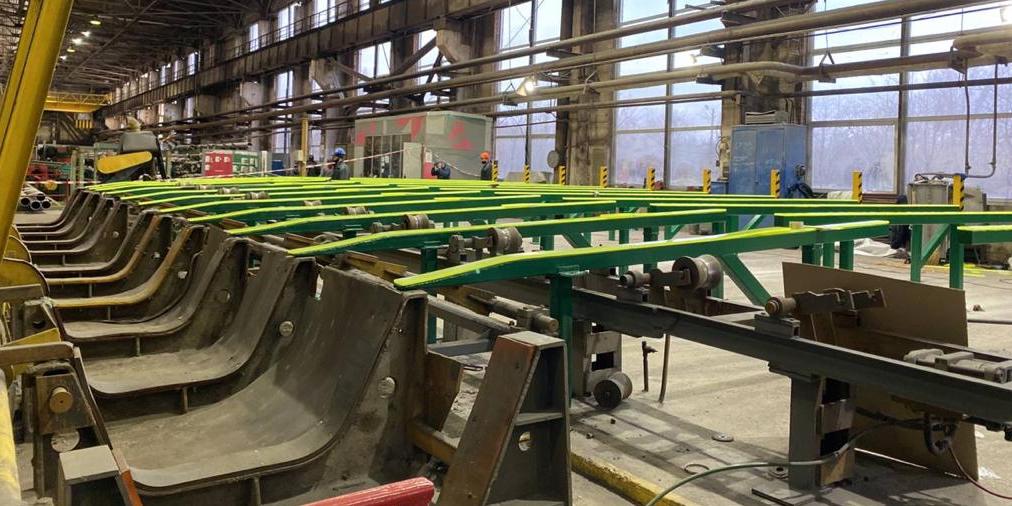
'Steel' going strong
FEATURE – With the help of Lean Thinking, this Ukrainian producer of stainless steel pipes is retaining its competitive position against larger players in the market.
Words: Luca Di Santo, Lean Transformation Leader, Centravis - Ukraine
Until the year 2000, the area around Nikopol was home to the Nikopol Yuzhnotrubny Plant (NYTP), one of the largest industrial complexes in the Soviet Union. After the dissolution of the USSR, NYTP was dismembered into a number of factories. Today, two of them belong to Centravis, a producer of seamless stainless steel tubes and pipes.
Even though our products represent a niche in the market segment of steel piping, Centravis has been able to become a global player competing with large corporations (unlike us, many of them are vertically integrated). For sale volumes, we are number 9 globally and number 1 in the former Commonwealth of Independent States (Soviet Union). We have a robust presence in Europe since many years and are trying to expand in the United States and Asia.
For a few years now, Yuri Atanasov, the company’s owner and CEO, has pushed for a cultural shift towards Lean Thinking. In fact, there have been a number of attempts to transform the business in the past, which were not so effective and ultimately failed. This gave our people “consultants fatigue” and made them weary of the next recipe for improvement cooked up by the external expert du jour. For the past year, we have been partnering with Serhii Komberianov of the Lean Institute Ukraine to address some of the issues that we hadn’t tackled in our previous attempts and to help Centravis to embrace Lean Thinking once and for all.
Last year, as the pandemic hit, we were forced to let go 25% of our staff (today, we employ 1,500 people). Luckily, towards the end of 2020, orders started to pick up – the first signs of a recovery that seems to be growing more and more robust every month. Despite this, our management team wants Centravis to learn to do more with what we have – without any extra investment in resources. Our current focus is, therefore, on boosting our production capacity and on finding efficiencies in those segments in which Centravis is not competitive enough. Lean is the perfect approach for that.
We realized that to achieve the results we want – including the financial ones – we need to change the way we think. A couple of years ago, when I joined Centravis, we were working with a Polish consultant and rolled out a huge training program. In hindsight, this was not a good approach for two reasons: 1) we didn’t spend enough time and energy developing middle and top managers, which resulted in a lack of synchronization between the front line and different levels of management; and 2) we strived to train all of our 1,500 people as quickly as possible (each of them was expected to complete 60 hours of training), which proved impractical, and failed to give people ways to put into practice what we were teaching them.
With the help of Lean Institute Ukraine, we have adopted a different approach: creating pilot areas to run experiments in and inspire others to follow suit. After just one year, we have a couple of “model lines” that have become powerful examples within Centravis of what lean can achieve. In one of them, we have implemented a Toyota-like system in which a team leader ensures quality and makes sure there are no interruptions to the flow of production. There, running a few experiments with standardization and a better organization of the work was enough to improve productivity by 15-18%, with no additional investment or resources. In another area, using Total Productive Maintenance and SMED, we have markedly increased the OEE of some of our equipment and reduced scrap from 3% to less than 1% (with our older machinery, which requires a lot of manual labor, we have seen slower progress – but still a reduction of scrap from 6 to 4%).
We have chosen these areas because their work is directly linked to business problems whose resolution is of strategic importance for the company. I believe these powerful internal examples of lean prowess are giving our transformation legs, because they are inspiring to our people.
We are bringing lean to areas outside manufacturing, too. In October 2020, we introduced A3 Thinking in administration. We have trained managers in lean leadership there and taught our people to use value stream mapping to understand their processes in depth.

LEAN FOR OUR STRATEGY
Another priority for us is the introduction of hoshin kanri. We want to get to a point where every single person working here understands what their contribution is to Centravis’ overall strategic objectives. Right now, this is missing. There is a lack of alignment between the top and the bottom of the organization, and no standards across our management system. This means that we engage in a lot of activities but struggle to tie them together, which I believe is making our work harder. I know in my mind where we are going, but until that’s clear to every single worker, we won’t be able to reach our objectives.
I believe that hoshin will be a game changer for us, even though alone it won’t be enough. We also need to cause a shift in mentality at management level and help our leaders to understand that they have to be the drivers of change. It’s not up to external consultants to come in with their magic wands and turn things around overnight. Indeed, where our leaders are already driving the transformation, we are seeing great progress already! To help in this transition, we have changed the way we train our leaders, too, asking the managers themselves to teach and coach their peers.
Front-line people will follow you, as soon as you can show them that lean change is not a threat to them and that, in fact, it will make their lives easier. But managers are different, and I think their reluctance is often the biggest hindrance a lean transformation can face. That’s what we are trying to tackle now.
THE AUTHOR

Read more


FEATURE – Faced with increased production volumes, this Dutch company realized the need to improve its processes by developing people skills.


SAVE THE DATE – Our editor introduces the theme of this year’s Lean Global Connection, which focuses on rethinking leadership to ensure our organizations can tackle daily issues while keeping an eye on their long-term strategy.


INTERVIEW - Jim Morgan looks back at his years at Ford Motor Company and talks about the challenges and opportunities of applying lean management ideas to new product development .


OPINION – In a competitive and unpredictable market, the temptation to rely on technology is always strong, but experience proves that there is no better support than people's ability to learn and adapt to new situations.

